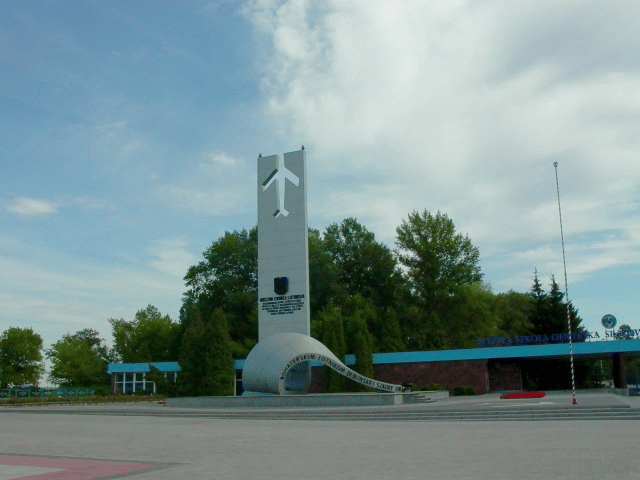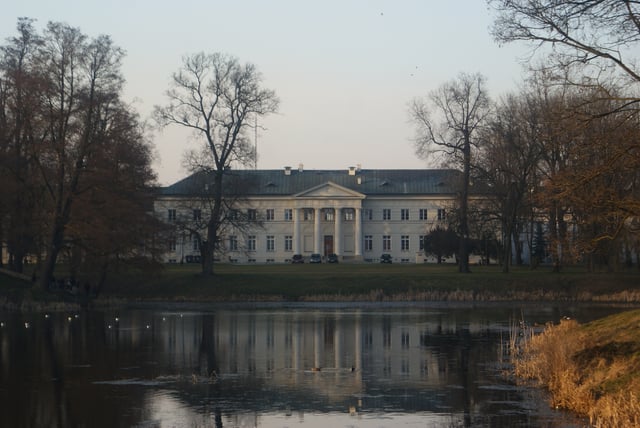Dęblin

Dęblin

Dęblin | |
|---|---|
| Coordinates:51°34′0″N 21°51′41″E [5] | |
| Country | |
| Voivodeship | Lublin |
| County | Ryki |
| Gmina | Dęblin (urban gmina) |
| Government | |
| • Mayor | Beata Siedlecka |
| Area | |
| • Total | 38.33 km2(14.80 sq mi) |
| Elevation | 115 m (377 ft) |
| Population (2016) | |
| • Total | 16,656 |
| • Density | 430/km2(1,100/sq mi) |
| Time zone | UTC+1 (CET) |
| • Summer (DST) | UTC+2 (CEST) |
| Postal code | 08-530 |
| Car plates | LRY |
| Website | http://www.deblin.pl/ [6] |
Dęblin [ˈdɛmblʲin] is a town, population 16,656 (as of 2016), at the confluence of Vistula and Wieprz rivers, in Lublin Voivodeship, Poland. Dęblin is the part of the agglomeration with adjacent towns of Ryki and Puławy, which altogether has over 100 000 inhabitants. Dęblin is part of historic province of Lesser Poland, and for centuries the area of the town belonged to Stężyca Land, Sandomierz Voivodeship. Since 1927 it has been the home of the chief Polish Air Force Academy (Polish: Wyższa Szkoła Oficerska Sił Powietrznych), and as such Dęblin is one of the most important places associated with aviation in Poland. The town is also a key railroad junction, located along the major Lublin – Warsaw line, with two additional connections stemming from Dęblin – one westwards to Radom, and another one northeast to Łuków. Dęblin is home to a sports club Czarni.
Dęblin | |
|---|---|
| Coordinates:51°34′0″N 21°51′41″E [5] | |
| Country | |
| Voivodeship | Lublin |
| County | Ryki |
| Gmina | Dęblin (urban gmina) |
| Government | |
| • Mayor | Beata Siedlecka |
| Area | |
| • Total | 38.33 km2(14.80 sq mi) |
| Elevation | 115 m (377 ft) |
| Population (2016) | |
| • Total | 16,656 |
| • Density | 430/km2(1,100/sq mi) |
| Time zone | UTC+1 (CET) |
| • Summer (DST) | UTC+2 (CEST) |
| Postal code | 08-530 |
| Car plates | LRY |
| Website | http://www.deblin.pl/ [6] |
History
Dęblin was first mentioned as a village in historical documents dating from 1397. At that time, it was ruled by Castellans from Sieciechów, and belonged to Lesser Poland's Sandomierz Voivodeship. The village was owned by several Polish noble families (such as the Mniszech family) until 1836 when it was taken over by the government of the Russian-controlled Congress Poland. In 1840 the village was handed to Russian field marshal Ivan Paskievich, who played a prominent role in the suppression of the November Uprising. From then on until the end of Russian rule in this part of Poland (1915) Dęblin was often referred to by its new Russian name of Ivangorod.
In the years after the November Uprising the military significance of the Dęblin site, at the confluence of two important rivers (the Vistula and the Wieprz), was noted. In the years 1838–1845 the Ivangorod fortress was constructed, sited to protect a crossing across the Vistula. After 1859 the fortress was further expanded. In the early 1880s a railway line connecting Lublin with Silesia was built, with a bridge over the Vistula passing near the fortress, further enhancing its importance. In 1854 the core of the present-day town, at its founding named the Irena Colony, was established. It kept its name until 1953 when it was incorporated into the town of Dęblin.
The fortress played a role in World War I. In October, 1914 a significant battle was fought in its vicinity, in which the Russian armies repelled a combined German and Austro-Hungarian offensive. After that battle the defences of the fortress were further improved, and it became even more important as an anchor of the Russian position on the Vistula. However, reverses elsewhere along the front forced the Russians to abandon Ivangorod in August 1915. In 1920, the Dęblin area was the starting point for a Polish offensive that decided the fate of the Battle of Warsaw and the entire Polish–Soviet War. In the years 1918–1939, as part of independent Poland, Dęblin continued to have large military significance. The Dęblin fortress was garrisoned by the 15th Infantry Regiment of the Polish Army, and in the nearby village of Stawy one of the largest ammunition depots of the Polish Army (Główna Składnica Uzbrojenia nr. 2) was located. In 1927 the famous Polish Air Force academy was officially moved to Dęblin, after its founding in Grudziądz in 1925 (some pilot training has been conducted here since 1920). It continues to function today.
During the Invasion of Poland, Dęblin was captured by the Wehrmacht on September 15, 1939. Under the German occupation, its Jewish population perished during The Holocaust. Dęblin was a location of a German POW camp Stalag 307 during World War II, and a large number of Soviet POWs (as well as those of other nations) died in camps established nearby. The town was seized by the Red Army on 25–26 July 1944. In the postwar years the city was rebuilt and expanded. It received its city charter in 1954.
Stawy Ammunition Depot

Mniszech Palace
Stawy, now a district of Dęblin, was a separate settlement in the Second Polish Republic. It is located along rail line from Dęblin to Ryki, among pine forests. Stawy has a population of 500.
In January 1921, construction of Ammunition Plant began in local forests. The name of the plan was soon changed into Main Ammunition Depot Nr. 2. At that time, the location of the depot was not named, it was simply called "Forest Barracks". On July 1, 1924, Minister of Military Affairs, General Władysław Sikorski officially changed the name Forest Barracks into Stawy.
The depot at Stawy was one of the largest such facilities in the interbellum Poland. During the Invasion of Poland, it provided ammunition to the fighting troops. In late September 1939, General Franciszek Kleeberg, commander of Independent Operational Group Polesie ordered his soldiers to march to Stawy, and capture the depot. Kleeberg however did not know that in mid-September the depot was blown up by order of General Stefan Dąb-Biernacki, commander of the Polish Northern Front (1939). The operation was carried out by soldiers of the 39th Infantry Division (General Bruno Olbrycht). Nevertheless, Kleeberg and his soldiers failed to capture Stawy, as they capitulated in early October 1939, after the Battle of Kock (1939).
Other
In the Chicago suburb of Oak Lawn, Illinois, which has a high concentration of Polish Americans, one of the streets bears the name of Dęblin Lane.
People associated with Dęblin
Konstantin Kaufman - was born
Michael Alfred Peszke - was born
Ignatz Bubis - lived 1935–1944
Witold Urbanowicz - graduated from the flying school
See also
1st Flying Training Centre

